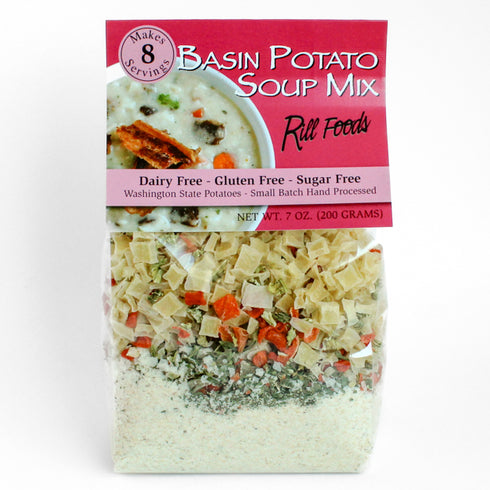Product of Washington State

Rill's Specialty Soups are a Product of Washington State.
Great Ideas for Dressing up your Basin Potato Chowder
| Milk Substitute | Cashew milk. Using blender, add 1-1/2 cups water and 1/2 cup raw cashews. Blend until creamy. Use equal amounts as a milk substitute. |
| Add | Add 1/2 cup white wine or 1/2 cup sour cream. Top with grated cheddar cheese or Velveeta cheese or chives. Substitute bacon with ham, sausage or kielbasa. |
| Vegetarian | Prepare without bacon. Use 15 oz. vegetable broth and reduce water by 2 cups. If desired add meat substitute. Add any of your favorite vegetables such as carrots, summer squash, etc. Add salt and pepper to taste. |
Tidbits of History - Columbia River Basin
The Colombia River Basin was home to Native Americans for thousands of years. The oldest know location of human inhabitants in Northwest America is found in the Basin and dates back between 9000 and 11,000 years ago. Various bands of Native Americans came to the Columbia River during salmon season to get their winter food supply.
White settlers first started to explore and settle in the region in 1835. It was a popular place to set up missions and the famous Whitman Massacre of 1847 happened in the Columbia Basin. In 1883 settlement began in the region, with the development of the Northern Pacific railroad. Ten years later the Great Northern Railroad followed encouraging even more settlement in the area.
The Basin area is renowned for its dry, arid, and dessert like land. In the early 1900’s residents began to eye the Columbia River for the potential of electricity and irrigation water. Two different plans were originally proposed to irrigate the Basin area, one consisted of a plan to carry water in 130 miles of canals and aqueducts to the Basin area and the other proposed a dam to be put on the Columbia River at Grand Coulee. It took until 1931, thirteen years after both plans were proposed that a decision was made that a dam was a better idea.
The Dam was still not started until Franklin D. Roosevelt came into office in 1932. Today Grand Coulee Dam provides electricity not only to Washington State but also to much of the Northwest. Currently the dam is used to irrigate 500,000 acres of land as the full completion of the project has been delayed. The Native Americans have viewed the Grand Coulee area as a place with sacred spirits and have relied on much of the Basin valley for food.
What makes the Basin unique in the growing of potatoes are the climatic conditions, rich volcanic soil, abundant water and a long growing season. Resulting in the basin lands producing the highest yield per acre of potatoes in the world. There are more than 160,000 acres planted annually, harvesting averages of 30 ton per acre, almost double the yields in the rest of the United States. The Basin area produces 20% of all U.S. potatoes.
History of Potatoes
In the Andes Mountains of South America, Pre-Columbia farmers discovered and cultivated the potato some 7000 years ago. In this harsh climate with poor soil conditions and fluctuating weather, the farmers were impressed with the plant’s hardiness, nutritional advantages and the ability to be stored. The Spanish discovered the tubular in 1537 when they marched through Peru but it was considered to be a poor mans food and was used predominately to feed hospitalized inmates.
It took three decades for the potato to gain popularity throughout the rest of Europe. In France, Antoine Augustine Parmentier, a pharmacist, chemist and employee of Louis XV realized the benefits of potatoes. He found the nutritional benefit of the potato, combined with it productive capabilities, could be a boost to the French farmer. After failing by conventional means to convince the Frenchmen of its many advantages, he decided on a surreptitious plan to make his point.
Parmentier acquired an unproductive plot of ground just on the outskirts of Paris. He planted 50 acres of potatoes and during the day hired a guard to look over it. When evening arrived, the guard was let go and the locals came to see what was of such importance. Many of the peasants believed that this plant must be very valuable and therefore took it upon themselves to “acquire” some from the plot. Soon they were growing the potato in their own gardens.
The potato gained wide acceptance across Europe and soon made its way to North America. Over time, the potato has become one of the major food stuffs of the world.
Free Shipping -
All orders of $50 or more qualify for free shipping excluding Traxxas RC vehicles. RC vehicles ship for $9.99 - $12.99 each (in-state vs. out of state).
Free Local Delivery -
Within Kittitas County (M-F)
Returns & 100% Money Back Guarantee -
If within the first 15 days after receiving your order you would like to return your item(s) for any reason, call 509-925-9851 or email Order@Jerrols.com and we will email you a return label to print and use to ship back to us via USPS.









